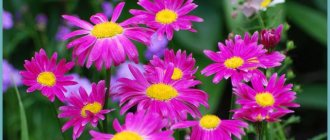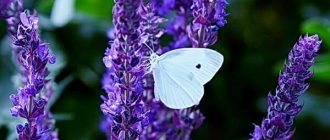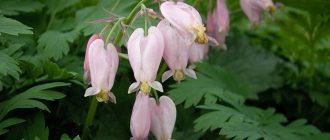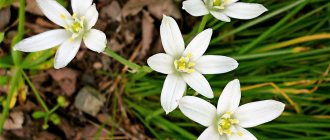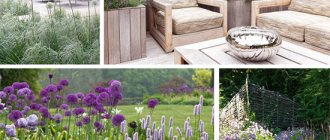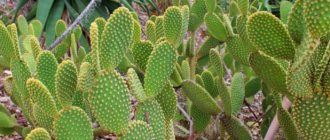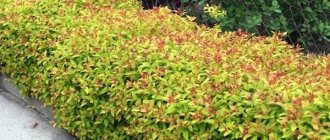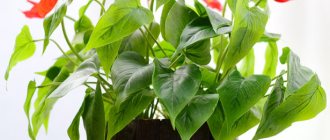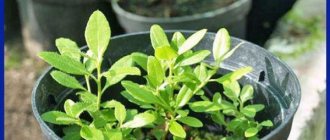Botanical description and beneficial properties of flax
Perennial flax belongs to the genus Flax and the Flax family. A herbaceous plant with vertical roots and shoots reaching a height of up to 80 cm. The bushes are decorated with green leaves 5 cm long and 3 mm wide, having a pointed shape and small denticles along the edges.
The flowers of perennial flax, 2-3 cm in diameter, have a white, blue color and are located on straight peduncles, attract attention. They consist of 5 petals, which fall every day and grow overnight, blooming only on sunny days before lunch.
Pleases with flowering from July to August. After which fruits appear, which are boxes up to 7 mm long, in which small, flattened, oil-coated seeds are formed.
Blooming flax not only decorates the landscape, but is actively used in medicine and cosmetology, since its seeds have a therapeutic effect and have a rejuvenating and healing effect on the human body:
- increase the body’s resistance to the effects of all kinds of viruses and infections;
- improve blood circulation and normalize blood pressure;
- promote rapid digestion of food;
- cleanse blood vessels from cholesterol plaques;
- free the body from toxins, carcinogens and other dangerous substances;
- help cope with depression and prolonged loss of strength.
The plant is also widely used in cooking; it is added as oil when baking and preparing various dishes.
Brief description of the genus
There are about 200 species in the flax genus, among which the most interesting for a gardener are low-growing compact bushes up to half a meter high, most of them perennials. Flowers can be of various sizes, from small to large, and the color of the corollas is blue, red-pink and white. The shoots are thin, but very strong, thanks to which the plant retains its shape even in unfavorable weather conditions.
Flax is naturally widespread in Africa and North America and is found in some places in Europe and Asia. In the conditions of the Middle Zone, it is successfully cultivated by flower growers, because flax perceives the conditions of a temperate climate as comfortable.
What you need to grow a plant
Gardeners are planning to decorate their local area or summer cottage with garden flowers, cold-resistant and quickly flowering crops. But not everyone has the opportunity and desire to grow flower seedlings for a long time. Perennial flax can be successfully grown by sowing seeds directly into open soil. At the same time, the plants will bloom for the next season. To enjoy earlier flowering, you can sow before winter.
After 4 years, flax needs to be rejuvenated, since its decorative qualities deteriorate with age..
Therefore, for cultivation you will need high-quality planting material, when choosing which you need to take into account the following parameters: the seeds must have a shiny surface and yellow-brown color, be heavy, oblong in appearance, with sharp ends.
See also
Planting, growing and caring for gladioli in open groundRead
What other “lazy” plants can be planted in the garden?
There is not always time to care for the garden and flower beds, but everyone wants to have their own fragrant corner on the site. Someone will say that this does not happen, and any plant requires attention. Of course, this is true, but the degree of care and its thoroughness differ. If you rarely visit the dacha, then not only large-flowered flax will suit you. Growing some other species from seeds will also come in handy. Pay attention to the openwork gypsophila. The perennial plant will cover the ground with an even carpet. You can also use an annual analogue - graceful gypsophila, it grows quickly and blooms luxuriantly.
Our traditional cornflower is simple and charming at the same time. Now many varieties have been bred not only with blue coloring, but also white, pink, and purple. In addition, the plant will delight you with a double wave of flowering - June and September.
We recommend choosing fragrant iberis or matthiola, toadflax, alyssum, which weaves everything into an even canvas, calendula (not only pleasant, but also useful), nasturtium for both horizontal and vertical gardening, and morning glory.
If you need an easy-to-care, but spectacular and unusual plant, look to the bright and cheerful large-flowered flax. Growing from seeds at home will help you get high-quality seedlings and plants that are stronger by the time they are planted in the ground.
Deciding on the variety
Of all the species diversity, when creating landscape design, gardeners give preference to the following varieties.
Decorative
A perennial ornamental plant 50-60 cm high, it has thin shoots that become woody in autumn, and flowers 5-6 cm in diameter, colored blue.
Under favorable climatic conditions, flowering continues from May to October.
Large-flowered
Flax of this species grows 40-60 cm in height. The stems are thin, branched, and decorated with narrow leaves. The plant has beautiful flowers 5-6 cm in diameter. The color palette is varied. The species has earned popularity due to its white, pink, lilac, and purple shades of flowers.
It pleases with its flowering from the first days of June to September.
Ordinary
A tall, branched plant 40-60 cm high. The bush is decorated with five-petaled blue flowers, the diameter of which is 3-4 cm. A perennial of this species is resistant to frost and drought, and grows well in the sun.
Blooms throughout the summer.
perennial flax
The plant grows up to 50 cm. Its stems are covered with small alternate leaves. The small flowers of a delicate blue shade with a diameter of up to 2 cm attract attention.
Blooms in June-July.
Perennial Heavenly
When blooming, this flower is compared to heavenly azure. The plant has small blue flowers that cover woody shoots. Compact bush reaching 50 cm in height.
Red
A bright bush, whose height is up to 45-50 cm and width 15-20 cm, has gained popularity due to its narrow light green leaves and large saucer-shaped flowers with 5 petals. The main feature of this species is that the flowers are predominantly bright red. They are located at the top of the stem and are collected in an elegant inflorescence, the diameter of which is no more than 3 cm.
Exuberant flowering begins in early spring and continues until October.
Grandiflora flax: cultivation
From small seeds, if desired, you can grow a beautiful perennial plant. Flax has an unpretentious character, is resistant to cold, and tolerates even mild frosts. It is preferable to choose sunny, well-lit areas for it. It will grow in any poor garden soil, but preferably without stagnant moisture. In Russia with cold climatic conditions, we recommend choosing large-flowered flax. Growing from seeds is very simple. Germination is almost 100%, and the plant spreads all the way to the taiga zone.
Before planting, the area must be dug up; it is recommended to add humus or compost (3-4 kg per 1 square meter). And also a tablespoon of superphosphate and potassium sulfate. Then mix everything thoroughly and level it with a rake. It is best to water the soil well and leave it for a couple of days, and only then start planting. This can be done in two ways: seedlings or directly into the ground. Choose the one that suits you best.
Planting in open ground
The culture is not particularly demanding when it comes to growing conditions, but the further development and comfort of flower growth depends on proper planting.
Selecting a location
Perennial flax is unpretentious in terms of growth conditions and care, but heavy soil and lack of solar heat will negatively affect the abundance and duration of flowering. Therefore, when choosing a site, you need to give preference to the most illuminated place, protected from drafts. It is important to avoid planting the crop in wetlands.
If groundwater is located near the surface, then drainage is necessary to increase soil permeability and drainage of excess water.
The soil should be loose and nutritious. Loamy soil with increased thermal conductivity, water permeability, and natural ventilation is considered ideal for perennial flax. .
Seed preparation
One of the important stages in cultivating perennial flax is preparing the seeds for sowing. Since the full growth and development of the crop and its abundant flowering directly depend on the quality of the seed material. Therefore, before planting, to prevent various diseases, the seeds must be treated using fungicides.
Timing and technology of planting work
Favorable time for sowing is April, May. It is important that the soil warms up to a temperature of 10 degrees. You can plant perennial flax in the fall before the first frost, and the average daily temperature should be at least 20 degrees.
Sowing is not recommended in rainy, damp weather..
The planting technology includes distributing the seeds over the surface at a distance of 20-25 cm. Then they need to be sprinkled on top with a thin layer of soil and moistened with a spray bottle. Shoots will appear after 2 weeks.
Planting and propagation
A simple and effective way to propagate flax is by seed. In the middle regions of Russia, flax cultivation begins with planting seeds in containers. Large-flowered flax, oil flax, low-growing flax, and many others are grown from seeds. A warm, bright room will allow seedlings to sprout within 20 days. If the climate allows, the stage of growing seedlings is skipped. Seedlings do not tolerate short-term night frosts, so you should wait until the air temperature stabilizes and the soil warms up. May-July is the safest time.
The agrotechnical sequence of actions is as follows:
- The soil is dug up and drainage made of crushed stone or sand is laid. The optimal layer thickness is 10 cm;
- soil mixed with humus is distributed on top;
- contribute 1 tbsp. l. mineral supplements: superphosphate, potassium sulfate;
- maintain an interval of 5 cm between bushes.
It is advisable to plant the crop in groups, since single specimens tend to the ground without support. Dense bushes are planted, a part is broken off from the base with at least one developed bud on it. Hard-to-grow shoots are dug up and cut, then planted separately. Sometimes gardeners take risks by planting seeds directly in open ground before winter, to a depth of 2-3 cm. Perennial species bloom only the next year. If flax is planted in early spring in warm weather, flowering occurs in summer.
In addition to growing flax from seeds, they also use the method of propagation by cuttings. The cutting process is carried out from April to August. Young and strong shoots at least 20 cm long are separated from the central specimen and planted in the soil to the level of the first leaf. The top is trimmed by 5–7 cm. The top is covered with film or glass. The cuttings are planted in a permanent place in the fall or spring of next year.
Any propagation option is not bad, but, based on the experience of gardeners, more lush and spectacular plants grow from seeds. Perennial representatives of the crop grow in one place for about 4 years. The transplant is poorly tolerated, so it is better not to disturb them again.
Sowing seeds in the ground
Before sowing flax seeds, the soil must be carefully leveled and rolled. Six months before planting, the flax seeds are treated, after which in the spring, when the top layer of soil warms up, the flax is sown. The sooner you plant flax, the sooner it will bloom. The best depth for sowing flax seeds is from 1.5 to 3 cm. Flax is sown in rows, with a distance of about 20 cm between them. During sowing, the seeds are scattered at a distance of about 5 cm between plants. It is possible more often, but with subsequent thinning. Alternative sowing by broadcast allows you to create denser and denser plantings.
Usually flax sprouts very quickly. Before planting, the soil is improved by adding compost or other organic fertilizers to the soil. Young flax seedlings are sensitive and fragile; to prevent them from being damaged by cold or wind, a shelter is prepared to protect the plantings. Over time, the seedlings will grow stronger and the plants will become invulnerable to unfavorable natural conditions.
Transfer
Flax flowers do not like transplantation and do not tolerate them well. Transplantation is ineffective and is practically not used by flower growers.
The use of flax seeds in folk medicine is very diverse. You can read more about this in this article.
How to sow flax in containers
Perennial flax seeds can be planted not only in open soil, but also in containers, but not for the purpose of growing seedlings, since this method is not effective. In this case, the container will be a permanent place for the development of perennial flax. And under favorable weather conditions, it can be taken outside, placing it in a well-lit area.
See also
Description and characteristics of subvarieties of rhododendron Rasputin, planting and careRead
Using flax for economic purposes
For the production of yarn, and then fabric, flax stalks were always collected in green form, but with already formed seeds in slightly yellowed boxes.
741c22f0225a33de2a258bf04d6f1266.jpg
Next, the plants were dried, tied into sheaves and stored under a canopy.
8d75b3737fbcfa8d6fd63973e52fd9e37b7723e9.png
Then the seeds were removed manually or using wooden devices, and in October, when the air temperature dropped, the dried straw was immersed in water to soak for about 3-4 weeks.
ctf9_byauay.jpg
The soaked and dried trusta (this is the name of this workpiece) was amenable to mechanical beating, kneading and combing. Subsequently, long and smooth tows were obtained, which were thin and very strong threads.
4ubbucubpgu.jpg
They were wound on a spindle and then used to spin fabric on special machines. Woody waste (from the fire) was burned, and tangled short fibers (tow) were used to insulate wooden houses, placing them in the gaps between the logs.
6221248244c9dd0b8f05663e61w9-materialy-dlya-tvorchestva-lnyanaya-domotkan-starinnoe-lnyano.jpg
As for flaxseed oil, it is used not only for food as a source of essential acids Omega-3,6,9, but also for industrial purposes: making quick-drying impregnation for wood, drying oil, varnishes and paints, polyethylene. Seed cake is a valuable feed additive for domestic animals (pigs, cows, goats).
Cultivation care
When growing, you need to create all the conditions for perennial flax for normal growth and abundant flowering, provide full care and attention, and then the results will exceed all expectations.
Watering
Perennial flax requires constant and moderate watering; the soil should be kept moist all the time. It is recommended to water the flowers with rainwater, and it is better to do this in the morning so that they have time to dry by the evening; shrubs that remain wet at night are susceptible to fungal diseases. The frequency of irrigation depends on the climate; generally, the plant should be moistened twice a week.
Weeding
Ornamental plants in a flower bed require regular weeding, which helps the gardener get rid of various weeds. This will create a beautiful and healthy appearance for the plantings and protect the perennial flax bushes from possible diseases and pest attacks.
Fertilizers
It is necessary to feed the crop 3 times per season: at planting, at the time of intensive growth and just before flowering. To do this, use complex mineral and organic fertilizers. You can use special mixtures for flowering ornamental species.
Do I need to cover it for the winter?
For the winter, perennial flax does not need shelter. But for better wintering, gardeners recommend covering the plant with spruce branches or fallen leaves.
Diseases and pests of flax: control and prevention
Perennial flax demonstrates disease resistance. Unless only a flax midge can take a fancy to it.
This problem cannot be solved with folk remedies, so it is recommended that if an insidious insect invades, you promptly treat the flowerbed using special chemicals.
Growing and care rules
In order for the plant to grow well, you need to know not only when to plant flax. It is also necessary to provide standard care: watering, fertilizing, weeding and loosening the soil.
The plant does not like overly moist soil, so before planting in heavy soil it is a good idea to provide drainage from sand or charcoal. The soil should be slightly moistened; depending on weather conditions, the bush should be watered 1-2 times a week; in the fall, moisture should be kept to a minimum.
During the growing season, crops are thinned and weeds are removed. Thickened plantings interfere with the normal growth of the plant, so they must be pruned from time to time. The soil around the plant is loosened, in this way it is saturated with oxygen.
Flax is resistant to pests and does not require frequent feeding. During the growth period, liquid organic fertilizers are applied 1-2 times. Before sowing the seeds, the soil can also be fertilized with potassium fertilizers. The crop is returned to its original planting site after 7-8 years. Potatoes, grains, and beans are considered good predecessors for the plant.
How does a plant reproduce?
Perennial flax can be propagated using one of the following methods:
- dividing the bush;
- cuttings;
- seeds.
The most common method of propagation is by seeds, since plants obtained in this way grow stronger and bloom more profusely.
Dividing the bush
When choosing this propagation method, you need to divide the bushes into parts in April or August after the flax has flowered, which are immediately planted in open ground, keeping a distance of 20 cm between them. In order for the plants to adapt faster and take root better, it is necessary to systematically water and protect from direct exposure to the sun.
Cuttings
This method of propagating perennial flax can be done from April to August. To do this, select powerful shoots, the length of which should be at least 20 cm, separate them from the bush and dig them into the ground at the level of the lower leaves. Shorten the upper part a little and put a glass cap on top. The cuttings will take root fully in the fall or with the onset of spring.
Seeds
Propagation by seeds can be carried out both in spring and autumn. To do this, scatter the seeds of perennial flax, keeping a distance of 5 cm between planting units. An alternative solution would be scatter sowing, which will allow you to make plantings that are dense and dense. Since flax has 100% germination, it is not recommended to thicken the crops. Young plant shoots are characterized by sensitivity and fragility and suffer from cold and wind, so care should be taken to provide shelter and protect the plantings in case of weather vagaries.
Perennial flax is considered a good option for garden fauna if the priority is winter hardiness, ease of care, and resistance to diseases and pests. In addition, the culture will add brightness to any compositional solutions and delight you with luxurious flowering throughout the summer season.
Decorative linen - ideas for a flower garden
For those who do not want to cultivate flax for yarn or harvest seeds on an industrial scale, this plant can become a simple and unpretentious decoration for the yard or garden. Airy sky-blue flowers of technical varieties will delight others throughout the warm season, and large-flowered species can successfully compete even with such exotic beauties as begonias, lobelias, and carnations.
l7-2.jpg
Linen looks very beautiful in the form of “islands” somewhere in the corners between trees, along a hedge of bushes, against the backdrop of large boulders. From airy sky-blue flowers it is easy to form a semblance of a flower stream, make a delicate frame along paths, or interestingly complement a fence or walls of buildings.
9-12.jpg
In mixed plantings, flax flowers are harmoniously combined with orange daylily and marigolds, pink cosmos, echinacea, and phlox. Meadow grasses will also be excellent neighbors for this discreet plant: daisies, cornflowers, bells, elecampane, and buttercups.
78.jpg
Application in landscape design
Masters of landscape design have long and successfully used several types of flax in their work: perennial flax, long-lasting flax, large-flowered flax, yellow flax, decorative flax and many others. In the home garden, flax looks elegant and cozy; borders are decorated with group plantings of flax. New Zealand flax, growing along garden paths or stairs, will give the garden a formal look and is ideal for creating a tropical or Spanish garden.
For fans of wildflower bouquets: flax placed in a vase is an amazing addition to the interior, capable of pleasing the eye for up to five days. Unlike other flowers, flax is not cut to make a bouquet, but rather dug up with its roots. At the budding stage, they are placed in water, and soon they open. The best neighbors for flax will be wildflowers: daisies, poppies, bells.
Every flora lover dreams of his own garden, where he can escape from city noise and dust, where he can lovingly cultivate each plant with his own hands, anxiously awaiting the fruits of his labor. Flower growers dream of creating their own corner of nature to their liking, where everything will correspond to their desires and needs. If you want to see something completely new, different, unusual on your site, we recommend planting flax.
